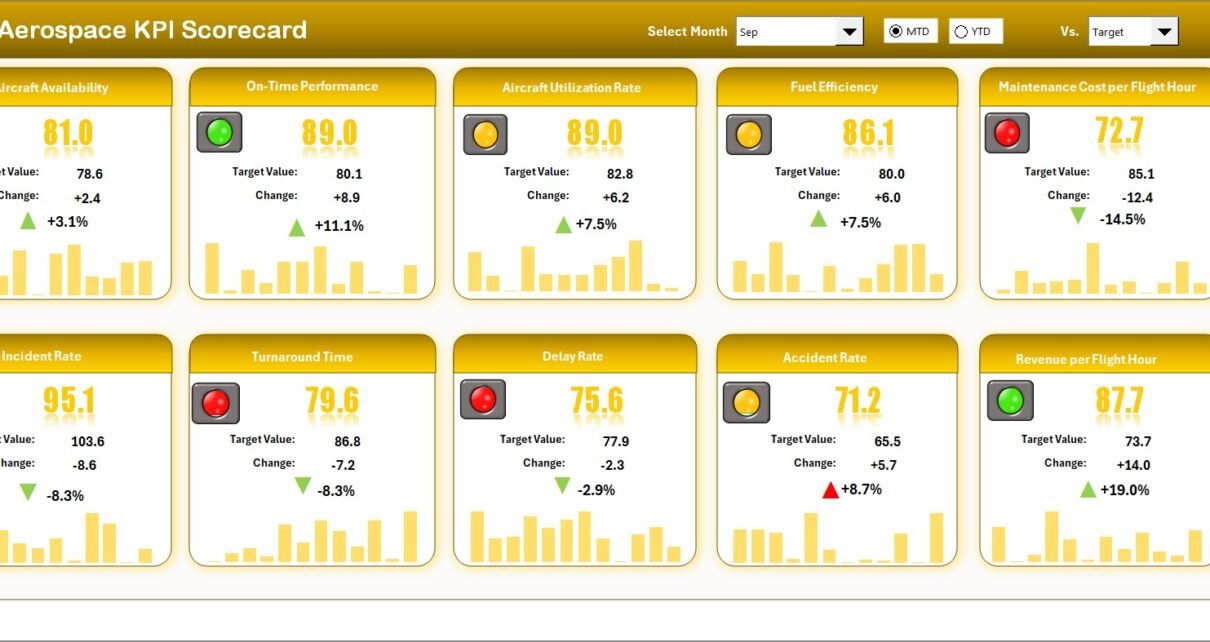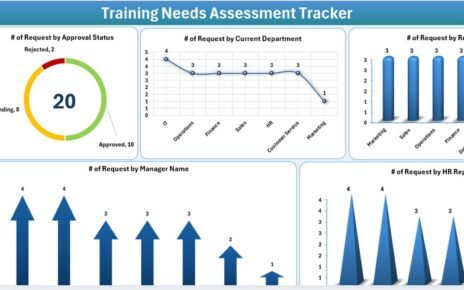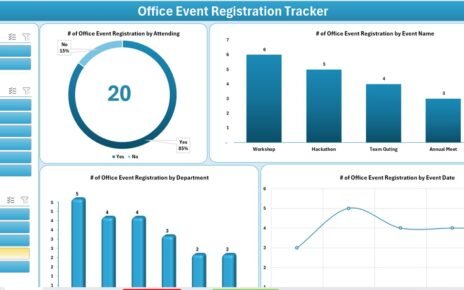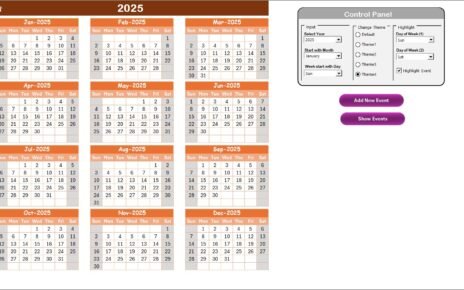In the fast-paced and highly technical world of aerospace operations, data accuracy and performance visibility play a critical role in ensuring success. Whether you’re managing manufacturing, maintenance, logistics, or research functions, you need clear insights into your key performance indicators (KPIs). That’s exactly what the Aerospace KPI Scorecard in Excel delivers — a ready-to-use, dynamic performance-tracking system designed to help aerospace professionals monitor operational efficiency, safety, cost, and quality in real time.
This article explains everything you need to know about the Aerospace KPI Scorecard in Excel — including its structure, functionality, advantages, and best practices. You’ll also learn how this tool empowers aerospace organizations to make data-driven decisions, reduce risk, and improve productivity.
Click to buy Aerospace KPI Scorecard in Excel
What Is an Aerospace KPI Scorecard in Excel?
An Aerospace KPI Scorecard is a structured Excel-based tool that helps organizations in the aerospace sector measure, analyze, and visualize performance metrics. It consolidates data from multiple sources — such as production, engineering, quality control, and logistics — into a single, interactive dashboard.
By comparing actual versus target performance and displaying MTD (Month-to-Date) and YTD (Year-to-Date) progress, the scorecard gives decision-makers a complete overview of business performance. It’s an ideal solution for aerospace companies looking to simplify KPI management without needing complex BI software.
Key Features of the Aerospace KPI Scorecard in Excel
The Aerospace KPI Scorecard template includes four powerful worksheets that make tracking performance simple, interactive, and visually appealing.
Scorecard Sheet – The Main Dashboard
The Scorecard Sheet acts as the central hub where all KPIs are visualized. It is designed for clarity and interactivity, allowing users to analyze performance from multiple perspectives.
Key highlights:
- Dropdown Menus: Choose between months, MTD, or YTD views to focus your analysis on specific periods.
- Actual vs Target Comparison: Instantly evaluate whether KPIs are meeting expected performance levels.
- Visual Indicators: Color-coded visuals and conditional formatting provide a quick “at-a-glance” understanding of results.
- Compact Design: Displays up to 10 KPIs in one view for immediate insight into mission-critical areas.
- Performance Overview: Presents both numerical and graphical summaries for improved decision-making.
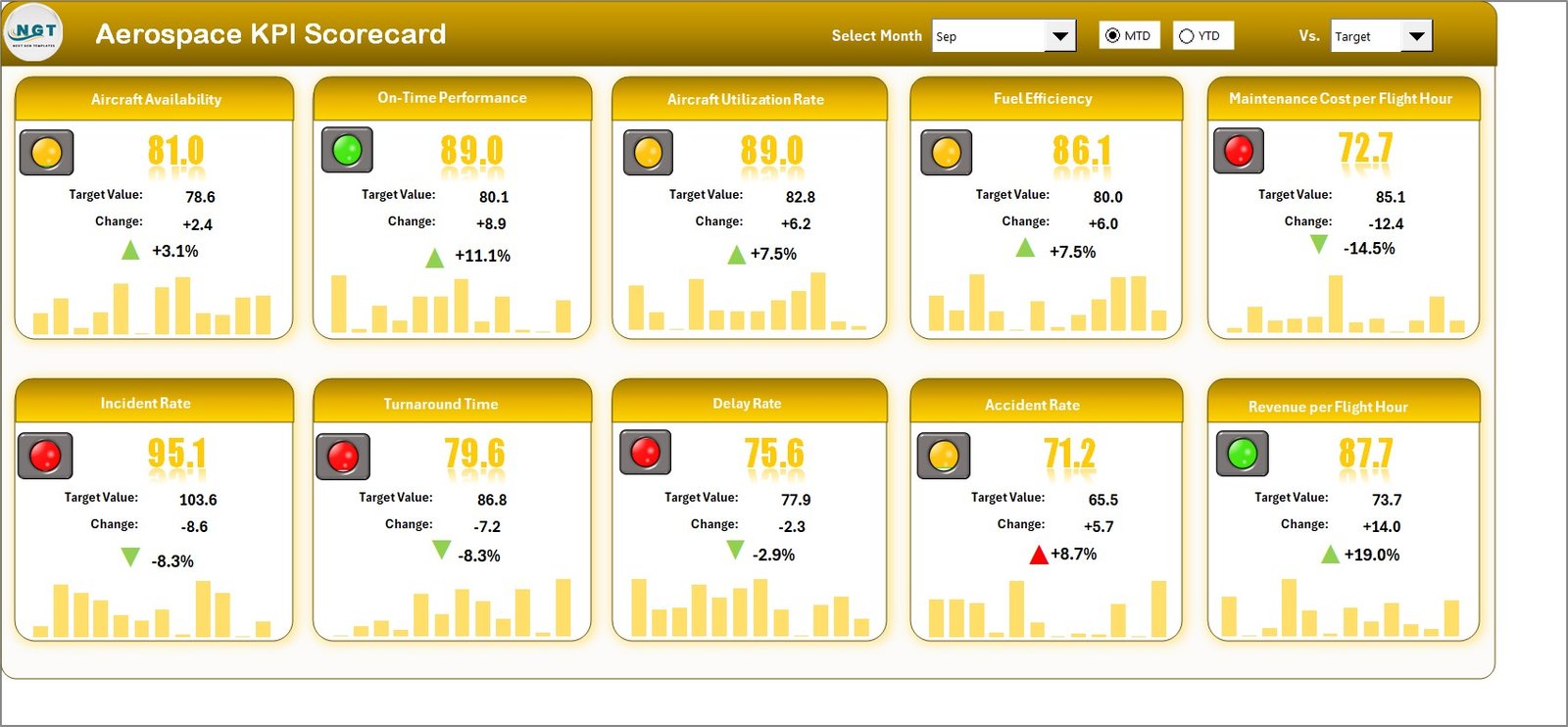
Click to buy Aerospace KPI Scorecard in Excel
KPI Trend Sheet – Performance Over Time
The KPI Trend Sheet focuses on visual storytelling through charts and trend lines. You can select a KPI from a dropdown (in cell C3) to view detailed historical performance data.
Features include:
- Dynamic KPI Selection: Pick any KPI to analyze its historical trend.
- KPI Details: Displays the KPI Group, Unit, Type (UTB or LTB), Formula, and Definition.
- Trend Charts: Compare Actual, Target, and Previous Year (PY) data using MTD and YTD trend visuals.
- Pattern Recognition: Identify improvement opportunities or performance dips quickly through visual trends.
This sheet makes it easy to monitor long-term performance patterns and evaluate whether strategies are producing sustainable results.
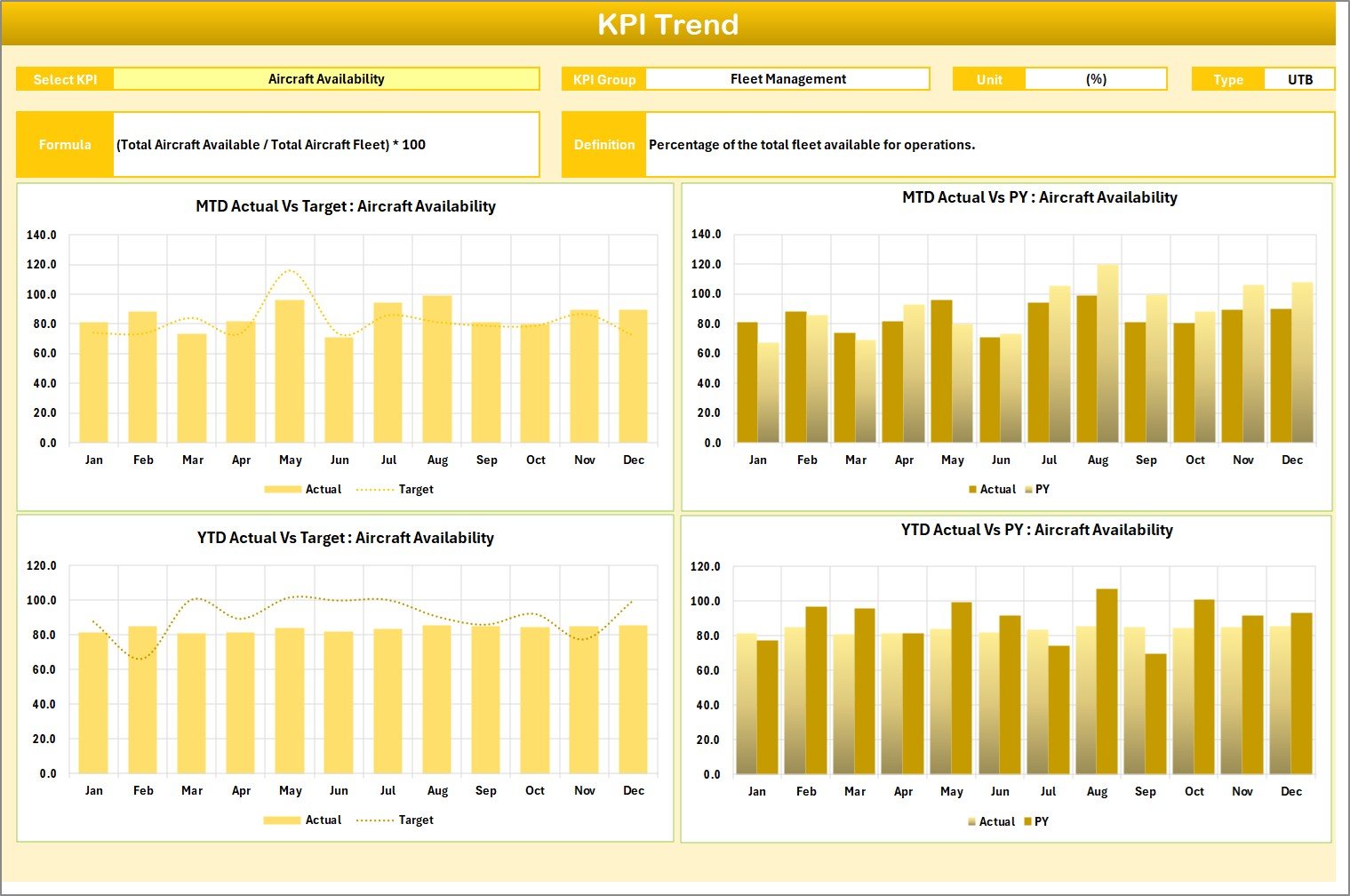
Click to buy Aerospace KPI Scorecard in Excel
Input Data Sheet – The Backbone of the Scorecard
The Input Data Sheet is where all raw performance data is entered. It forms the backbone of the entire scorecard.
Key highlights:
- Data Entry Section: Record actual values, targets, and previous year results for each KPI.
- Ease of Updating: Simply update monthly data as new performance metrics become available.
- Automatic Calculations: Once data is entered, all dashboards and charts update instantly.
- Data Accuracy: Reduces human error by maintaining a single data source for all calculations.
With its clean layout, even non-technical users can enter and update KPI data with confidence.
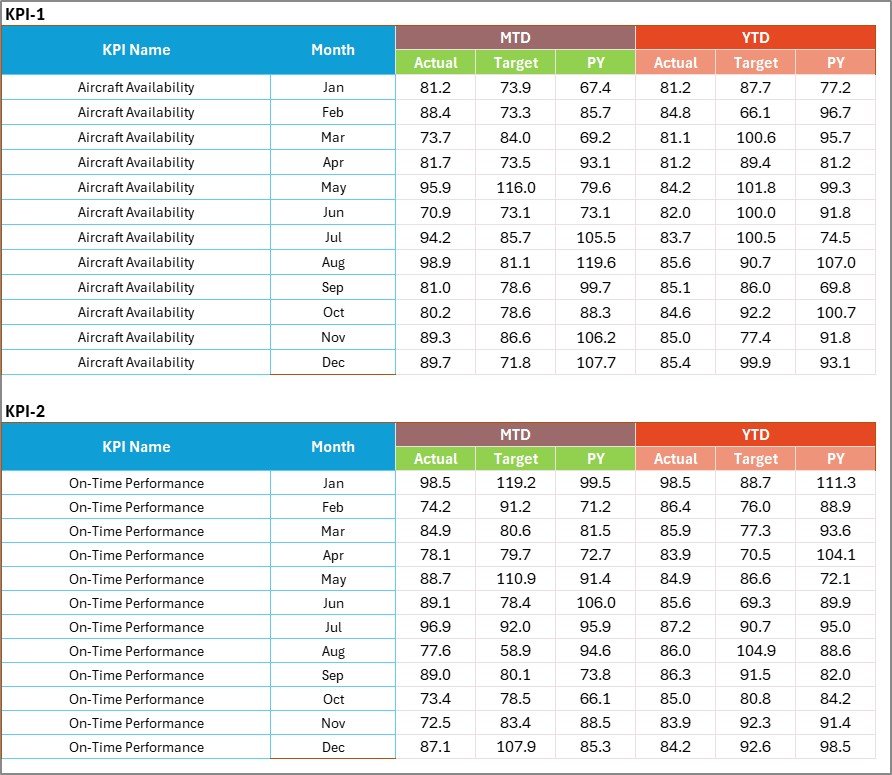
KPI Definition Sheet – Your Reference Database
The KPI Definition Sheet helps maintain consistency and clarity by storing detailed information about each KPI.
Includes columns for:
- KPI Name
- KPI Group
- Unit of Measurement
- Formula
- Definition
- KPI Type (UTB – Upper the Better / LTB – Lower the Better)
This ensures that all team members have a shared understanding of what each KPI measures and how it is calculated — a crucial aspect in aerospace operations where precision matters most.
Why the Aerospace Industry Needs a KPI Scorecard
The aerospace industry operates under extreme precision, safety, and cost pressures. Every delay, error, or non-compliance incident can have serious financial and reputational impacts. Tracking KPIs helps teams identify inefficiencies, maintain quality standards, and ensure regulatory compliance.
Here’s why a KPI scorecard is essential:
- Data-Driven Decision-Making: Helps leaders make accurate, evidence-based decisions.
- Improved Efficiency: Highlights underperforming areas in production, quality, or logistics.
- Regulatory Compliance: Ensures performance standards meet aerospace industry regulations.
- Enhanced Collaboration: Enables departments to align their goals with organizational objectives.
- Real-Time Insights: Provides instant visibility into critical KPIs for faster response times.
How to Use the Aerospace KPI Scorecard in Excel
Using the Aerospace KPI Scorecard doesn’t require technical expertise. Follow these steps to get started:
- Open the Template: Download the Excel file and open it on your system.
- Go to the Input Data Sheet: Enter actual and target data for each KPI month by month.
- Review the Scorecard Sheet: Use dropdowns to view MTD or YTD data for your selected month.
- Analyze Trends: Open the KPI Trend Sheet to study performance trends visually.
- Refer to Definitions: Use the KPI Definition Sheet to confirm formula details and definitions.
- Take Action: Use insights from the dashboard to improve operational performance.
The template updates automatically, ensuring your visuals and calculations stay current with every new entry.
Advantages of Aerospace KPI Scorecard in Excel
Implementing an Excel-based KPI scorecard offers several practical benefits for aerospace organizations:
- Simplifies Complex Data
Excel transforms complicated datasets into clear visuals, enabling faster analysis and decision-making.
- Affordable and Accessible
Unlike expensive BI tools, Excel is widely available, easy to use, and doesn’t require specialized training.
- Customizable Framework
You can easily add, remove, or modify KPIs based on your company’s needs or compliance requirements.
- Enhanced Visualization
Color codes, charts, and conditional formatting help teams instantly identify performance gaps.
- Improved Accountability
Since all departments can access shared KPIs, accountability and transparency increase across the organization.
- Supports Continuous Improvement
Regular performance tracking fosters a culture of improvement and operational excellence.
Best Practices for Using the Aerospace KPI Scorecard
To get maximum benefit from your Aerospace KPI Scorecard, follow these best practices:
- Define KPIs Clearly: Ensure each KPI has a specific goal, formula, and target.
- Maintain Data Consistency: Update the Input Data Sheet regularly to keep the dashboard current.
- Use Visual Cues: Rely on color indicators and trend lines to identify problem areas quickly.
- Encourage Collaboration: Involve multiple departments in reviewing scorecard insights.
- Automate Where Possible: Use Excel formulas and data validation rules to reduce manual work.
- Review Regularly: Conduct monthly or quarterly performance reviews using the scorecard.
- Benchmark Results: Compare your KPIs against industry standards to identify improvement opportunities.Aerospace KPI Scorecard in Excel
By applying these best practices, you can ensure that your aerospace KPI scorecard remains a living, breathing performance tool rather than a static report.Aerospace KPI Scorecard in Excel
Real-World Applications of Aerospace KPI Scorecard
The Aerospace KPI Scorecard can be adapted for various real-world applications:
- Aircraft Manufacturing Plants: Monitor production efficiency and defect rates.
- Maintenance and Repair Organizations (MROs): Track turnaround time and maintenance costs.
- Aerospace R&D Divisions: Measure project milestones, resource utilization, and testing accuracy.
- Aviation Logistics Teams: Assess on-time shipments, warehousing efficiency, and material cost control.
- Corporate Management: Align operational KPIs with strategic business objectives and budgets.
Each department can use the same scorecard while focusing on its own relevant KPIs, ensuring cross-functional alignment.
How This Template Improves Business Decision-Making
Data is only valuable when it drives action. The Aerospace KPI Scorecard turns raw data into actionable insights by:
- Providing instant access to key performance results.
- Highlighting underperforming KPIs that require immediate attention.
- Supporting what-if analysis through scenario modeling.
- Enabling historical trend comparison to evaluate long-term strategies.
- Offering transparency and accountability across all business levels.
With this tool, aerospace leaders can confidently answer questions like:
- Are we meeting our production targets this quarter?
- Which KPIs are improving compared to last year?
- Where should we allocate more resources or training?
Integration with Other Systems
Though built in Excel, the Aerospace KPI Scorecard can be integrated with:
- ERP Systems: Import data from SAP, Oracle, or Microsoft Dynamics.
- Power BI: Export Excel data for advanced visualization.
- Cloud Storage: Share files using OneDrive or Google Drive for real-time collaboration.
- Automation Tools: Use Excel macros or VBA scripts to automate data refresh.
This flexibility ensures that aerospace businesses can scale the scorecard as their data ecosystem evolves.
Conclusion
The Aerospace KPI Scorecard in Excel is more than just a spreadsheet — it’s a comprehensive performance management system tailored to the unique needs of the aerospace industry. With its structured design, real-time analysis, and customizable framework, it enables aerospace organizations to track performance, enhance quality, and achieve operational excellence.
Whether you’re a manufacturing manager, quality analyst, or operations executive, this scorecard helps you make better, faster, and more informed decisions. By turning data into insight, it empowers teams to soar higher — both operationally and strategically.
Frequently Asked Questions (FAQs)
- What is the main purpose of an Aerospace KPI Scorecard?
It helps aerospace organizations track and evaluate performance across production, safety, quality, and finance metrics in one interactive dashboard.
- Can I customize the KPIs in this Excel template?
Yes. You can add or modify KPIs, change formulas, and adjust targets according to your company’s operational requirements.
- Is this scorecard suitable for small aerospace businesses?
Absolutely. It’s perfect for both small and large organizations, as it doesn’t require advanced software or technical expertise.
- Does the scorecard include automated charts?
Yes. Once you update the Input Data Sheet, all charts and visuals refresh automatically across the Scorecard and Trend sheets.
- How often should I update the KPI data?
You should update KPI data monthly or as soon as new results are available to maintain real-time accuracy.
- Can I integrate this Excel scorecard with Power BI or ERP systems?
Yes. The template can be connected or exported to Power BI or ERP systems for advanced analytics and automation.
- What types of aerospace teams can benefit from this tool?
Manufacturing, maintenance, quality control, R&D, and logistics teams can all use this scorecard to monitor and improve their performance.
Visit our YouTube channel to learn step-by-step video tutorials
Watch the step-by-step video tutorial:
Click to buy Aerospace KPI Scorecard in Excel
